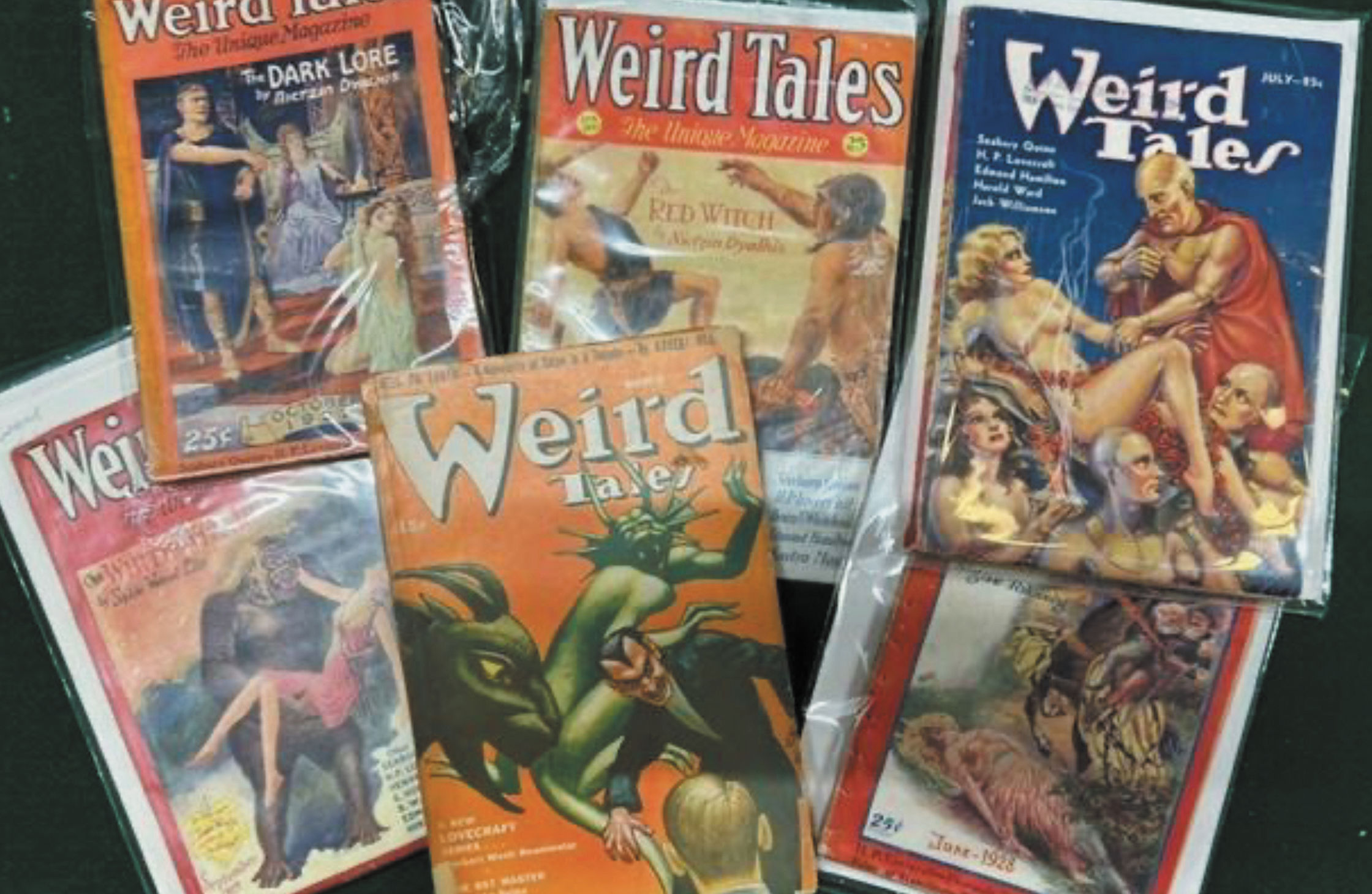Many of the stories by H. P. Lovecraft, including the Cthulhu Mythos, take place in Arkham, characterized by its eerie, supernatural atmosphere. Everyone associates Lovecraft with Arkham — and vice versa — but are you aware that Arkham House Books was created to publish Lovecraft’s books (and other sci-fi/fantasy titles)?
H. P. Lovecraft was an author of the pulp era, primarily writing for Weird Tales, an early fantasy and horror magazine. But it wasn’t long before Lovecraft published his novels: his first hardback — Shunned House — was published by W. Paul Cook in 1928 (The Recluse Press), which printed about 300 unbound copies. R. H. Barlow purchased 225 copies of the unbound pages and bound 8 copies, including one copy for Lovecraft himself. Arkham House later purchased 150 unbound copies (discussed below). Following the W. Paul Cook’s Shunned House, various pamphlets by H. P. Lovecraft were printed. Then in 1936, Visionary Press published The Shadow Over Innsmouth. 400 copies were printed but only 200 copies were bound — the rest seemingly discarded.
After these early abortive publishing activities, August Derleth and Donald Wandrei founded Arkham House Publishing in 1939. This small press publishing company was founded to publish the works of H. P. Lovecraft and became the primary publisher of horror/weird fiction and pulp literature. The Outsider and Others (1268 copies) was the first book published by Arkham House and sold out in about four years. Arkham House became the primary publisher of Lovecraft’s work in hardback. Arkham House then published:
Early Hardbacks
- Beyond the Wall of Sleep (1943) in 1217 copies
- Marginalia (1944) in 2035 copies
- The Dunwich Horror and Other Weird Tales (1945) as an Armed Service Edition paperback for free distribution to armed service personnel
- Something About Cats (1949) in 2995
- The Shunned House (1959) 50 copies of Paul Signatures were sold as unbound sets
- The Shunned House (1959) 100 copies of Paul Signatures were bound (without a dustjacket)
- The Shuttered Room and Other Pieces (1959) in 2527 copies
- Dreams and Fancies (1962) in 2030 copies
Later Hardbacks
- The Dunwich Horror and Others (1963) in 3000 copies
- Collected Poems (1963) in 2013 copies
- Autobiography: Some Notes on a Nonentity (1963) in 500 copies as a pamphlet
- At the Mountain of Madness (1964) in 3000 copies
- Selected Letters I, H. P. Lovecraft Selected Letters 1911-1924 (1965) in 2504 copies edited by August Derleth
- Dagon and Other Macabre Tales (1965) in 3500 copies
- Dark Brotherhood and Other Pieces (1966) in 3460 copies
- Tales of Horror (1967) in 1522 copies
- Selected Letters II, H. P. Lovecraft Selected Letters 1925-1929, (1968) in 2480 copies edited by August Derleth,
- Horror in the Museum and Other Revisions, (1970) in 4000 copies,
- Selected Letters III, H. P. Lovecraft Selected Letters 1929-1931, (1971) in 2500 copies edited by August Derleth,
- Selected Letters IV, H. P. Lovecraft Selected Letters 1931-1934 (1975) in 5000 copies edited by August Derleth,
- Selected Letters V, H. P. Lovecraft Selected Letters 1934-1937 (1976) in 5000 copies edited by August Derleth,
- H. P. Lovecraft (forward by Robert Weinberg), (Limited number/lettered edition) (2008) with 17 lettered and 100 numbered copies
Except for The Shunned House, the unbound sets of pages, and the Lovecraft pamphlets, these books were all issued with dustjackets. The later books also had multiple editions at Arkham House but not the early works. Numerous other publishers have done various H. P. Lovecraft books over the years, but Arkham House is the seminal publisher. They became the publisher for multiple authors from the pulps and Weird Tales type stories, including Robert E. Howard, Frank Belknap Long, August Derleth, Donald Wandrei, Brian Lumley, Ray Bradbury, Carl Jacobi, Basil Cooper, Michael Bishop, Joseph Payne Brennan, Ramsey Campbell, and many others.
In the early 1970s, Donald Wandrei initiated litigation against Arkham House but returned as editor for a short time after the death of August Derleth in 1971. April (Rose) Derleth then ran Arkham House until 2009 when George Vandenburgh (Battered Silicon Dispatch Box) and Robert Weinberg took over publishing activities. By circa 2022, Arkham House had gone out of business and their website disappeared. Before 1988, they had published 180 hardback books in the weird, fantasy, and science fiction genres.
Arkham House is the seminal press for the Cthulhu Mythos and weird fiction. It is an example of a small publishing company that had a mission to preserve a genre of literature and succeeded. Arkham wasn’t just the home for the Cthulhu Mythos: it saved a variety of Weird Tales-type stories from the pulps. But it also published similar types of stories from current-day authors. Arkham House publishing and publications have worn their ‘strange/weird’ atmosphere proudly, and we now associate the genre with the location of Arkham and the use of Arkham as an adjective.
This discussion about H. P. Lovecraft and Arkham House is partly based on the information in these references:
- Sheldon Jaffery, The Arkham House Companion (Starmount Reference Guide # 9), Starmount House, Inc, 1989
- Mark Owning and Irving Binkin, A Catalog of Lovecratiana, Mirage Press, LTD, 1975
- Levy, Maurice, Lovecraft A Study in the Fantastic, Wayne State University Press, 1988
- L. Sprague De Camp, Lovecraft A Biography, Ballantine, 1976
- S. T. Joshi, H.P. Lovecraft & Lovecraft Criticism, Wildside Press, 1981
- Barton Levi St. Armand, The Roots of Horror In the Fiction of H. P. Lovecraft, Dragon Press, 1977
- Howard Phillips Lovecraft, Supernatural Horror in Literature, Dover, 1973
- Charlotte Montague, H. P. Lovecraft Lovecraft, the Mysterious Man Behind the Darkness, Chartwell Books
- Arkham House, Wikipedia, 6/26/2023
- Donald Wandrei, Wikipedia, 6/26/2023
- abebooks.com
Steven Woolfolk is the owner of Xenophile Bibliopole & Armorer, Chronopolis

